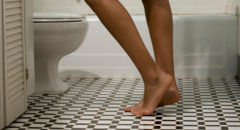
Overactive bladder syndrome has a wide variety of effects including social anxiety, depression, not to mention the effects it has on your organs. But what's more astounding is that nearly one in two Black women suffer from it, so you're not alone.
Here are a few herbal remedies and one new remedy you should try:
Horsetail is an herb used for a variety of ailments, including these symptoms of overactive bladder: urinary leaks (incontinence), bladder stones, urinary tract infections. Horsetail may also be used for “general disturbances” related to the bladder.
Saw palmetto plants are commonplace in eastern parts of the United States, such as Florida. While the tree might look good in your yard, some evidence suggests that it can do your bladder good, too. It is most effective in overactive bladder of men.
Cornsilk: Gathered from the silky, hair-like threads of the corn stalk, cornsilk has been a remedy for urinary infections for so long that even the ancient Incas once used it. Cornsilk may have a soothing effect on the urinary tract.
But, conquering your overactive bladder problem might also be helped by conquering the mind.
The mind may offer a new path to better bladder control and a way to sidestep some of the embarrassing side effects of an overactive bladder, a new study suggests.
Doctors at Loyola University Health System conducted a clinical trial using cognitive therapy for people with urge incontinence, also known as overactive bladder. They say they’ve found that cognitive therapy is an effective...
...management strategy for urge incontinence.
“The mind-body connection has proven to be particularly valuable for women suffering from incontinence,” study investigator Aaron Michelfelder, MD, associate professor in the department of family medicine at Loyola University Chicago Stritch School of Medicine, says in a news release. “Cognitive therapy is effective with these women because they are motivated to make a change and regain control over their body.”
The study evaluated 10 patients with a mean age of 62. They were eligible to participate if they had a diagnosis of overactive bladder -- a sudden and unstoppable urge to urinate.
Michelfelder’s patients attended an initial office visit and were introduced to the idea of cognitive therapy. They listened to a 15-minute audio recording with a series of relaxation and visualization exercises to do at home twice a day for two weeks. The study's cognitive therapy focused on changing a person's way of thinking in order to better control the bladder.
The patients tracked the number of incontinence episodes they experienced in a pre- and post-therapy diary. The majority of patients experienced a substantial improvement in symptoms.
Study investigators Mary Pat FitzGerald, MD, and Shameem Abbasy, MD, analyzed the results.
FitzGerald says the data revealed that the average number of urge incontinence incidents per week decreased from 38 to 12.
“Cognitive therapy may play a vital role in a comprehensive approach to treating this disorder,” she says in a news release.
One of the women in the study, Anna Raisor, 33, says the therapy worked for her.
“Before entering this clinical trial, I saturated seven to eight pads a day and was afraid to leave home as a result,” she says in a news release. “Today, I am 98% free of leakage. The therapy has allowed me to successfully recognize the link between my brain and bladder to manage my incontinence and remain virtually accident free.”
Michelfelder and colleagues say they demonstrated “statistically and clinically” that cognitive therapy helps people with urge incontinence.









